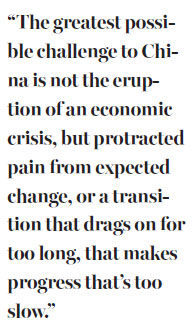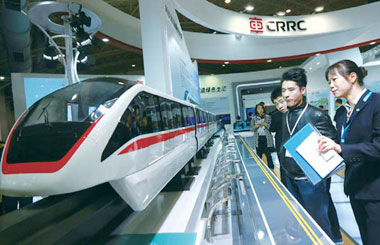Doomsayers missing the big picture
Updated: 2016-01-22 08:38
By Ed Zhang(China Daily Europe)
|
|||||||||||
Watchers who predict crisis misunderstand that China can handle currency, debt issues, but ignore challenge of sluggish reform
When the business cycle is low, or relatively low, every year begins with people forecasting an even gloomier future. So as long as this economy's transition continues, there will be plenty of China watchers predicting imminent financial crisis, or at least a financial crisis with the country as a main player.
But there is one trick in such doomsaying. It is true that China is faced by many challenges. But its currency, the renminbi, has yet to become fully convertible, and is unlikely to become so anytime soon, despite government promises of a more open economy.
With its ample US dollar reserves, the central government's exchange management should be able to fend off a direct hit to the renminbi from the international currency market.
The problem of China's mounting debt, notorious as it is, still looks manageable in a semi-closed financial system. Much of it, after all, is incurred by local governments. And it is common that at the city level, every government tends to have a lot of sellable assets. Almost every city government could sell its office building to the private sector, to be renovated into a school or a retirement home.

Having said this, one may realize that the greatest possible challenge to China is not the eruption of an economic crisis, but protracted pain from expected change, or a transition that drags on for too long, that makes too slow a progress.
The reform of state-owned enterprises, many of which are large and have a lot of assets they can't fully utilize, already seems too slow in comparison with the reform of the country's military leadership.
It was only a few short months from President Xi Jinping's announcement of China cutting 300,000 soldiers to rebuilding the command system into a more integrated central military commission. By contrast, a would-be new round of SOE reform, since its announcement in 2013, has shown little progress in any large SOE's restructuring, not even in a pilot project.
Such an imbalance cannot be attributed only to a lack of courage for SOE reform. There are too many things to slow down the process. SOE workers are unlike soldiers in the first place, and cannot be discharged or relocated at short notice, even though many SOEs do not control the technologies to make themselves competitive, and can only see their value go downhill year after year.
To a great extent, the difficulty in offloading uncompetitive SOEs reflects a broad picture. The reform itself, correcting an imbalance, is unlikely to be a well-balanced process. For SOEs, the change can only be very slow, if it ever comes at all. Some have to become less important, or even marginalized, before they really begin to change the way they operate, like the Chinese state postal system.

Will the private and nonstate sector, in which the state may own a small share, make faster progress in the meantime? In theory, it may. So for all investors with an interest in China, any growth in the nonstate sector, especially in this distressing time, is a bright spot to watch.
The nonstate sector is China's real advantage when making a comparison with the 1990s. The sector was small and weak when it began its first transition from a Soviet-style planned economy to an export-led growth model.
The difference now is that a number of large companies have arisen from this sector, either privately owned or managed entirely in the market economy style despite their SOE background.
In the first couple of weeks in January alone, Wanda, a real estate developer-turned-entertainment investor, acquired the Hollywood studio Legendary; and Haier, formerly a small factory from the state sector and now a publicly listed home appliance maker, acquired GE's consumer appliance division. Each deal was worth several billion US dollars.
There is no way to tell whether such major deals will work out as expected. One can be certain that, overall, Chinese companies will incur huge expenses as they go about overseas business expansion. Some major deals will collapse.
But to know which part of China's economy will generate more growth, one need only compare nonstate sector companies and SOEs in their motivation and effectiveness in seeking changes.
A robust private and nonstate sector can help China avoid a crisis in its slow and troublesome SOE reform, although it remains unclear how it can help redirect the SOEs' redundant workforce.
The author is editor-at-large of China Daily. Contact the writer at edzhang@chinadaily.com.cn
(China Daily European Weekly 01/22/2016 page13)
Today's Top News
Global push
AIIB chief vows to run clean, lean, green institution
'More Europe' to deal with 'triple crisis'
China gives beleaguered Tsipras a helping hand
China injects note of confidence in Davos
China and Gulf nations resume free trade talks
IMF starts to select new chief
Merkel insists on European solution for refugee crisis
Hot Topics
Lunar probe , China growth forecasts, Emission rules get tougher, China seen through 'colored lens', International board,
Editor's Picks

|

|

|

|

|

|






